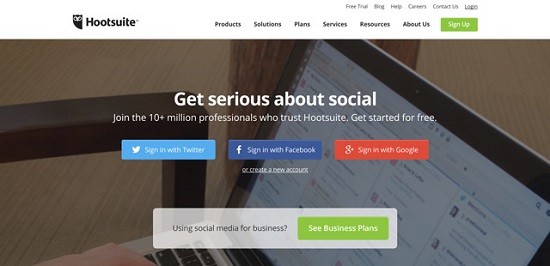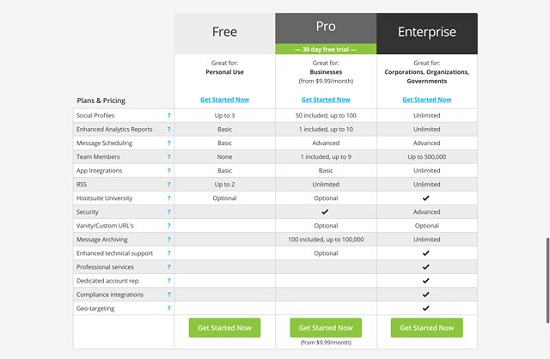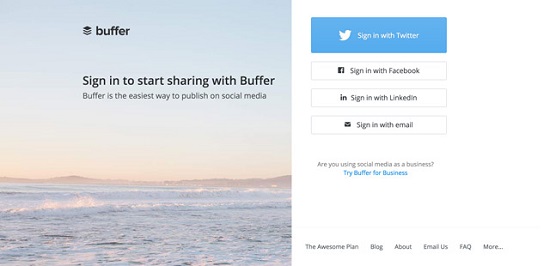Social Media: Rock Your Business with Facebook, Twitter, …

Usually we start into a new year with a lot of energy, new goals and resolutions. But eventually we reach the point - which is at the beginning of Spring at the latest - when our weaker self prevails and we mess up our goals and resolutions. If one of your goals for 2015 was to use social media efficiently, maybe to get a new job or boost your business, don't lose track of it. Create an easy-to-follow social media plan and implement it consequently. Such a strategy plan for social media use doesn't need to be a screed. One single page strategically positioned somewhere will always catch your eye and keep you on target. All you need to do is to take a moment and draw up this plan. We'll give you a helping hand to get you up and running!
 Source[/caption]
Source[/caption]
 Hootsuite is a comprehensive tool with an analysis function for all connected social media networks. OAuth is the standard login, but you can also create a "classic" user account with your name, email address, and password. The free version allows you to add only three accounts. If you want more, you'll need to get a premium account. The "Pro Plan" starts from $9.99/month. The drawback: Hootsuite relies on its own URL shortener ow.ly and doesn't allow other tools, like the popular Bit.ly. So, if your strategy is based on several building blocks but should be analyzed overall, Hootsuite might not be the best choice.
Here's an overview of the functions and costs:
Hootsuite is a comprehensive tool with an analysis function for all connected social media networks. OAuth is the standard login, but you can also create a "classic" user account with your name, email address, and password. The free version allows you to add only three accounts. If you want more, you'll need to get a premium account. The "Pro Plan" starts from $9.99/month. The drawback: Hootsuite relies on its own URL shortener ow.ly and doesn't allow other tools, like the popular Bit.ly. So, if your strategy is based on several building blocks but should be analyzed overall, Hootsuite might not be the best choice.
Here's an overview of the functions and costs:
 Video of the Google Chrome extension "Hootlet"
[embed width="550"]http://youtu.be/NNpwbO8vvuU[/embed]
Available apps: iPhone | Android | Google Chrome extension
Video of the Google Chrome extension "Hootlet"
[embed width="550"]http://youtu.be/NNpwbO8vvuU[/embed]
Available apps: iPhone | Android | Google Chrome extension
 Buffer is easy and intuitive to use. You can connect to Facebook, Twitter, LinkedIn, App.net and Google+ (only sites, not profiles); however, the amount of posts is limited. You can schedule only ten posts per connected social media account. The next better option would be the so-called "Awesome Plan", which costs $10/month and allows 100 posts. OAuth is provided but you can also use the "conventional" login using your email address and password.
Other than Hootsuite, Buffer works perfectly with your (potentially) existing Bit.ly account. Note: The Bit.ly account needs to be connected to every single profile on Buffer.
A beginner's video to Buffer
[embed width="550"]http://youtu.be/L7MJs9lclvQ[/embed]
Available apps: iPhone app | Android app | Google Chrome extension
Buffer is easy and intuitive to use. You can connect to Facebook, Twitter, LinkedIn, App.net and Google+ (only sites, not profiles); however, the amount of posts is limited. You can schedule only ten posts per connected social media account. The next better option would be the so-called "Awesome Plan", which costs $10/month and allows 100 posts. OAuth is provided but you can also use the "conventional" login using your email address and password.
Other than Hootsuite, Buffer works perfectly with your (potentially) existing Bit.ly account. Note: The Bit.ly account needs to be connected to every single profile on Buffer.
A beginner's video to Buffer
[embed width="550"]http://youtu.be/L7MJs9lclvQ[/embed]
Available apps: iPhone app | Android app | Google Chrome extension
Draw up a Social Media Strategy in Few Steps
1. Determine Your Goals
What's your goal with social media? Do you want to increase traffic on your website by 30%? Or maybe connect with a new influencer once in a week? Whatever your goals may be, write them down to make them measurable.2. Determine Your Target Market
With whom do you want to connect via social media? Specify your target group as accurately as possible. And, if possible, slip in demographic, geographic, and psychological characteristics. Mind correct job titles if applied. In short, be as specific as possible.3. Choose the Right Platform
Which platform suits best to reach your goals and target group? If your target group consists mainly of middle-aged males working in the lower management, Instagram might be the right choice. If you sell, let's say, wedding dresses, go for Pinterest. Other platforms wouldn't really make sense in that case. Taking this into consideration, analyze your brand, your company, and yourself.4. Observe Carefully
Before creating profiles or your first post, you should study competitors, opinion leaders, and potential customers. What do they post? What kind of posts get the most attention? Which hashtags work best on Twitter or Instagram? Which LinkedIn groups have the most competitors, opinion leaders, and potential customers? First, get a clear picture about the surrounding, and then start creating your profile and fill it with content.5. Create Personality
Try to create some personality. When you get to this point of your plan, take your time to describe in few sentences the brand and personality of your company. If your company was a person, what would you write? Would this person be humorous? Would this person be a fan of something? If you want to create a personality for yourself, think about which part of yourself you want to share with the world in posts and which you don't. For example, many people don't want to share family matters with the world. My advice: Check out your competitors' profiles - how do they describe and present themselves or their company? What personality do they give themselves? In other words: What kind of brand have they created? That's what it's all about - creating a brand; and that requires personality.6. Create a Profile
If you represent a company it's now time to get a graphic designer who creates your Twitter background or Facebook header image.7. Develop a Post Strategy
How often do you want to publish posts in a social media network and/or your blog? If you represent a company, ask yourself whom you want to authorize with publishing posts. Which kind of product should be posted in which social media network? And above all: Who will be in charge of replying to comments and how much time does this person have for that? Keep in mind that it's extremely important in social media networks to reply immediately to customer comments. Let this aspect slip in to your strategy.8. Analysis
Once you've developed your post strategy and made your first posts, it's important to analyze the results. Either with your homepage's analysis tool if you want to check the results of your blog entries, or with the social network's analysis tool. Answer yourself the right questions, for example, have sells increased, if and how many recruiters have contacted you, the success of promotion codes, and so on… Compare the results with your goals and, if necessary, optimize either your post strategy or your goals afterwards. [caption id="attachment_90476" align="alignnone" width="550"] Source[/caption]
Source[/caption]
9. Automate Your Posts
Once you feel comfortable handling posts for social media networks, it's the right time to automate this process. Schedule your posts a couple of days in advance for certain times that work best for you. You can still publish posts immediately; however, scheduled posts allow consistency. And consistency is an essential factor for success in social media networks.Tools to Automate Social Media Posts
As it has proved to be practical to schedule and automate not only blog articles but also posts in social media networks, we'll show you two excellent tools. Both offer a free account with useful functions.Hootsuite
 Hootsuite is a comprehensive tool with an analysis function for all connected social media networks. OAuth is the standard login, but you can also create a "classic" user account with your name, email address, and password. The free version allows you to add only three accounts. If you want more, you'll need to get a premium account. The "Pro Plan" starts from $9.99/month. The drawback: Hootsuite relies on its own URL shortener ow.ly and doesn't allow other tools, like the popular Bit.ly. So, if your strategy is based on several building blocks but should be analyzed overall, Hootsuite might not be the best choice.
Here's an overview of the functions and costs:
Hootsuite is a comprehensive tool with an analysis function for all connected social media networks. OAuth is the standard login, but you can also create a "classic" user account with your name, email address, and password. The free version allows you to add only three accounts. If you want more, you'll need to get a premium account. The "Pro Plan" starts from $9.99/month. The drawback: Hootsuite relies on its own URL shortener ow.ly and doesn't allow other tools, like the popular Bit.ly. So, if your strategy is based on several building blocks but should be analyzed overall, Hootsuite might not be the best choice.
Here's an overview of the functions and costs:
 Video of the Google Chrome extension "Hootlet"
[embed width="550"]http://youtu.be/NNpwbO8vvuU[/embed]
Available apps: iPhone | Android | Google Chrome extension
Video of the Google Chrome extension "Hootlet"
[embed width="550"]http://youtu.be/NNpwbO8vvuU[/embed]
Available apps: iPhone | Android | Google Chrome extension
Buffer
 Buffer is easy and intuitive to use. You can connect to Facebook, Twitter, LinkedIn, App.net and Google+ (only sites, not profiles); however, the amount of posts is limited. You can schedule only ten posts per connected social media account. The next better option would be the so-called "Awesome Plan", which costs $10/month and allows 100 posts. OAuth is provided but you can also use the "conventional" login using your email address and password.
Other than Hootsuite, Buffer works perfectly with your (potentially) existing Bit.ly account. Note: The Bit.ly account needs to be connected to every single profile on Buffer.
A beginner's video to Buffer
[embed width="550"]http://youtu.be/L7MJs9lclvQ[/embed]
Available apps: iPhone app | Android app | Google Chrome extension
Buffer is easy and intuitive to use. You can connect to Facebook, Twitter, LinkedIn, App.net and Google+ (only sites, not profiles); however, the amount of posts is limited. You can schedule only ten posts per connected social media account. The next better option would be the so-called "Awesome Plan", which costs $10/month and allows 100 posts. OAuth is provided but you can also use the "conventional" login using your email address and password.
Other than Hootsuite, Buffer works perfectly with your (potentially) existing Bit.ly account. Note: The Bit.ly account needs to be connected to every single profile on Buffer.
A beginner's video to Buffer
[embed width="550"]http://youtu.be/L7MJs9lclvQ[/embed]
Available apps: iPhone app | Android app | Google Chrome extension
Conclusion
It's essential to have a strategy before starting to use social media networks. You can only reach a goal if you have set one. So, draw up that strategy, be patient, prove that you have perseverance, and you'll get far. This is the first step to increase the range and popularity of your products. Social media is hard work that requires a lot of diligence and staying power.Related Links
- Wikipedia: Influencer marketing
- Hootsuite
- Hootsuite apps: iPhone | Android | Google Chrome extension
- Buffer
- Buffer apps: iPhone app | Android app | Google Chrome extension

Cool post Andreas, we use Hootsuite at Sem Zoom and particularly like the publisher tools that help us surface audience relevant content in seconds.
Choosing the right platforms is really important for your engagement. Its really pointless posting content that wont resonate with your audience.
You need to bare in mind that your audience demographics will change across platform too. You might find that your own audience is younger or older depending on the platform for example.
Hi,
Ok, I think the best suggestion in your article is #4, to observe. I have a question about it:
In your experience, how much time should someone spend reviewing what others do and taking notes, before starting his or her own work?
Hi,
Thank you for your article. Unfortunately, from my point of view, scheduling and automating posts in social media networks is not useful. I prefer posting about trend topics.